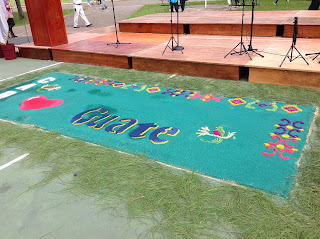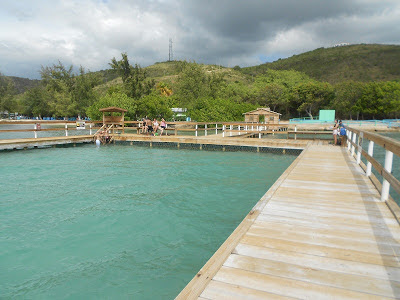The State of Things
It’s an exciting time to live in Guatemala. Though I don’t usually follow current events
or even attempt to stay up to date on the political scene here in Guate, over
the past few months, it’s been impossible not to. And what has been happening has been simply
remarkable.
 |
| Alfombra at our school to celebrate Independence Day |
I am still by no means an expert, but I think almost
everyone here in the city now has at least a basic understanding of what’s been
going on. I’ll attempt to keep this
update accurate and concise.
To begin, we have to go back a few months, to the
spring. It was at that time that the
then-vice president of Guatemala, Roxanna Baldetti, was linked to a corruption
scandal. This news sparked a campaign
called RenunciaYa (“Resign Already”) which called for the resignations of both
the vice president and the president (who people assumed was involved, though
no formal accusations were made).
Baldetti resigned in May, but President Perez Molina did not step
down.
All summer, peaceful protests were held on Saturday
afternoons in Zone 1 of Guatemala City, people with signs and chants demanding
the president resign. He did not.
Things began to come to a head in August. As the presidential elections grew nearer, evidence
came to light implicating the president and the first formal accusation against
Perez Molina was made. Just two weeks
before the election, the president gave a speech. Many thought he would finally announce his
resignation, but instead, he proclaimed his innocence and lashed out at the UN
group that has been spearheading the corruption investigations.
The speech sparked a massive uprising. A protest was planned for August 27th
that would shut down the city. Schools (including
mine) cancelled classes for the day, businesses closed, and thousands of
citizens took to the streets. The university
students started marching from their campuses, picking up more and more people
until they reached the Parque Central in zone 1. Over 100,000 people gathered that day to
demand the president’s resignation. And
remarkably, the entire event remained peaceful.
In this violent country, that fact alone is amazing and wonderful.
 |
| The beginning of the march, in Zone 15 |
Unfortunately, the protest achieved no visible results—at
least not right away. If the president
were to resign, he would lose his immunity and be subject to investigation for
corruption charges. By remaining
president, he prolonged his freedom.
So the government took matters into their own hands. First the supreme court, and then the
congress, voted to strip the president of his immunity. The final vote in congress was 132 to 0 in
favor of renouncing his immunity.
As soon as Perez Molina was stripped of his immunity, a
warrant was put out for his arrest, and he resigned the presidency a few hours
later. And the people of Guatemala
rejoiced.
Yet the future of this small country is not yet clear. Things are moving in a positive direction,
but in September 6th’s presidential election, no one on the ballot
seemed to be a good choice; most of the candidates are known or suspected to be
just as corrupt, if not more so, than the previous administration.
One candidate in particular, Manuel Baldizon, is known to be
bad news. In the days before the
election, lawmakers lobbied to have his party removed from the ballot due to
charges of bribery and corruption during his campaign. The motion was not successful, and Baldizon
remained on the ballot. Yet another civilian
campaign was in motion called “No Te Toca Baldizon” (“It’s not your turn, Baldizon”).
The fight to keep Baldizon from getting elected was just as
fierce as the fight to get Perez Molina to step down. While everyone I spoke to or heard from in
the city was anti-Baldizon, the problem was conveying the message of the
candidate’s corruption to the poorer citizens of Guatemala (which is sadly a
huge percentage of the country). It’s
hard to convince someone that a person is a poor choice for president when all
they know about him is “He gave me a bag of food and necessities,” or, as is
rumored (but perhaps not confirmed to be true), “He said he’d give me a job if
I voted for him,” or “He said he’d pay us if we voted for him.”
The morning of September 7th, the day after the
vote, Guatemalans were disappointed, but not without hope. The leader in the presidential race (which
will go to a second round of voting between the top two candidates from the
first vote) was Jimmy Morales, a comedian who apparently has acknowledged he
knows very little about politics but had the charisma and the team to be
elected. Manuel Baldizon and Sandra
Torres were (are) neck and neck for 2nd and 3rd place. Currently, Torres leads by 1.2% (less than
6,000 votes), and Baldizon is claiming the elections were fraudulent and is
pushing for a re-vote between him and Torres.
For now, though, it appears that #NoTeToca was successful. But in the effort to keep Baldizon from the
presidency, no one pushed hard enough for the right candidate.




Comments
Post a Comment